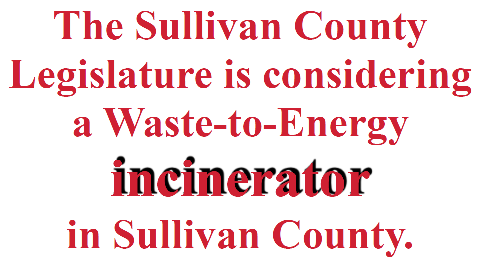
The Skinners Falls Bridge is Gone. Don’t Let It Happen Again!
May 20, 2025Last September 14 we posted extensive information related to the Sullivan County Legislature proposing to build a so-called “waste-to- energy” incinerator in eastern Sullivan County to solve Sullivan County’s waste disposal problem citing concerns about the pending loss of the Seneca Meadows municipal solid waste landfill in Seneca Falls, NY where Sullivan County waste is now transported to. Now Seneca Meadows will close next year and the discussion in the County Legislature continues. DCS is urging looking into other, less destructive alternatives that incorporate recycling and pre-burn waste reduction to reduce the pollution and destructive side effects that incineration can inflict on people and the environment.
Incinerators release toxic air and water pollutants, like dioxins, PFAS, mercury and other heavy metals, that poison surrounding communities and the entire planet. They also generate hazardous waste in the form of toxic ash that must be transported to special toxic waste dumps.
But Sullivan County is considering building a “waste-to-energy” (WTE) facility—that is, an incinerator—to burn our and possibly other counties’ trash. Be advised, the so-called “waste-to-energy” title is just an incinerator by another name. For years, the incineration industry has been falsely ‘greenwashing’ their operations as non-toxic, taking false advantage of tax subsidies and credits that the “green” status confers, only to skip out, leaving their customers to foot the bill from staggering construction debt and the inevitable costs associated with the environmental pollution and illness that remain long after the incinerator has ceased operating.
Download waste to energy Facts to Review as a pdf.
The pollution and these facilities’ “put or pay” contracts have resulted in the actual or near bankruptcy of several municipalities (reference to Detroit and in other US areas, PA, MD, CA).
Also, Sullivan County’s highly positive and growing farming sector would be hurt by the pollution from an incinerator.
Better Trash Options for Sullivan County – May, 2025
Download Better Trash Options as a pdf
What Sullivan County has now:
- Single stream ‘recycling’ collection at transfer stations.
- Bags of mixed solid waste and trash collection at transfer stations.
- Private trash collection of mixed waste from individual homes, businesses & municipalities.
- Limited single stream ‘recycling’ (e.g. cardboard, newspaper, tires) mixed with all the rest collected together often gets landfilled.
The County Legislature is considering a Waste-to-Energy incinerator in Sullivan County.
Why avoid incineration? – including Waste to Energy (WTE) incinerators?
Incinerators produce pollution of air, water and land.
Incinerators are economically destructive to surrounding areas by;
- Lowering property values
- Discouraging tourism/second homeowners
- Endangering human health – plants and animals are harmed
- 1/3 of the weight of the burned material is toxic ash, requiring costly special handling. None of the recyclable, sale-able materials are saved.
- WTE incinerators are very expensive to build, produce minimal energy (not sale-able amounts) and often mean the operating municipality must import trash to meet volumes required by the facility or pay more under their “put or pay” contracts.
How to avoid incineration?
Reduce overall trash volume by:
- Maximizing what the public recycles, repurposes and reuses. Recycled materials can be resources with monetary value.
- Engaging businesses, schools, government and other public facilities to also recycle.
- Establishing universal composting programs for households, multi-family units and businesses (especially food related) and for yard wastes.
- Construction and demolition materials to be recycled as much as possible.
- Commit to increasing community education, and tracking waste reduction progress.
What is needed to avoid incineration – Reduce the trash volume!
- Sullivan County needs a materials recycling facility that eliminates single stream collection and reduces overall trash volume by 25 to 30% by people self-sorting their items.
- Encourage Rescue & Repair options, like ‘Repair Cafes’ for highest reuse of items.
- Universal composting programs that are easily and readily available.
- Initiate “Pay as you throw” charging by weight at transfer stations as as an incentive for people to minimize trash. Any inappropriate dumping must be penalized.
WHAT TO DO? – Be informed, learn about options and implications, contact county legislators (they will be making the decisions), write Letters to the Editor, help educate other people.
For a blueprint to reach these goals – see Community_Zero_Waste_Roadmap:
“ON THE ROAD TO ZERO WASTE”
Read more:
New Data Links Waste Incinerators to Toxic Contamination
A Backlash is Growing Over Incinerating Garbage




